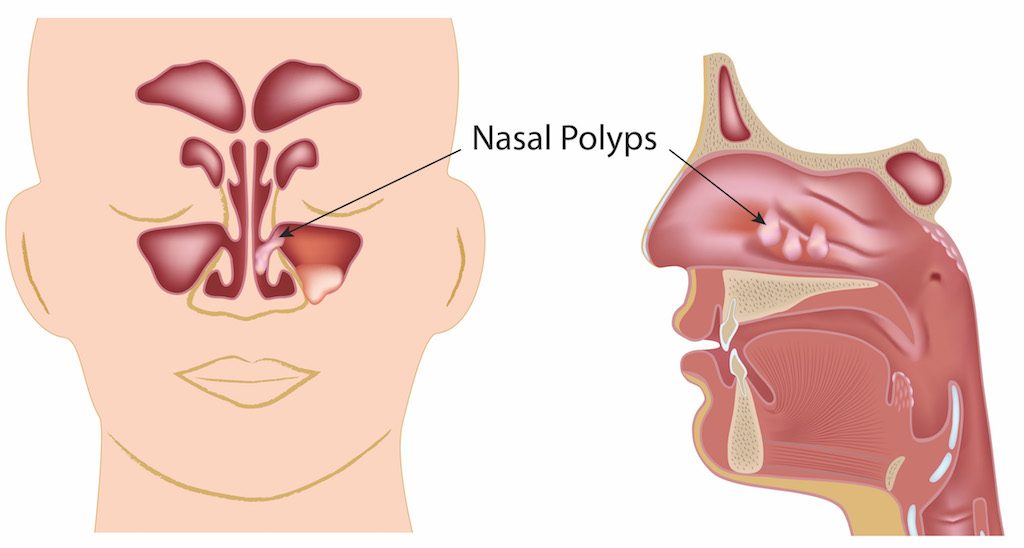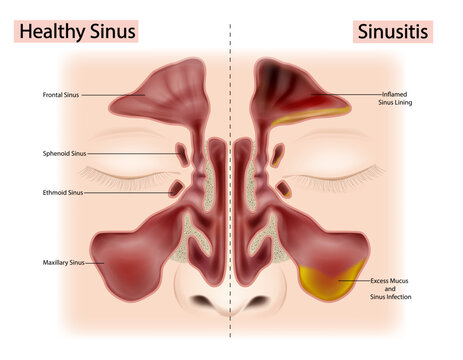Nasal Airway Blockage
Is it tough to breathe through your nose? There are many reasons why nasal breathing can be difficult. From a deviated septum to nasal polyps to turbinate hypertrophy, there are a myriad of structural and functional components that contribute to how open your nose feels.

- Deviated septum: when the partition between the right and left sides of the nose is crooked or slanted. This may have arisen due to trauma, such as a nasal fracture, or from the way your facial structures developed. This can be corrected with a straightforward outpatient surgery called a septoplasty. Recovery time is typically 5-7 days.
- Turbinate hypertrophy: when the “shelves” inside the nose are enlarged. This can happen as a result of longstanding turbulent airflow (which is common with a deviated septum), or from environmental allergies. This can be corrected with an in-office procedure, called a turbinate reduction, or in combination with a nasal surgery in the operating room.
- Nasal valve collapse/stenosis: when the critical angle inside the nose is too narrow. When you increase the diameter of the nasal valve, it dramatically decreases airway resistance. In fact, doubling the diameter of the valve will decrease resistance to airflow by 16X! This is based on a principal of physics called Poiseuille’s law. The nasal valve can be widened via an in-office procedure (Latera or VivAer) or in the operating room using a variety of techniques, including rhinoplasty.
- Nasal polyposis: when long-term swelling leads to growths in the nose, which are essentially sacs filled with inflammatory tissue. Once formed, these typically do not resolve on their own. Surgery can be performed to clear the polyps, open up the breathing passages, improve sense of smell and decrease post-nasal drip.
- Tumors and masses: when a neoplasm (tumor of unknown type) is present in the nose, it can cause a blockage, as well as other symptoms. A nasal endoscopy is a 5-minute in-office procedure that is used to rule out neoplasm. A biopsy can be performed (in clinic or in the operating room) if needed.
Environmental Allergies
Inhaled allergens (a.k.a. aeroallergens) in the environment can trigger ear, nose and throat symptoms. Some allergens, such as pollens, are seasonal, but many are year-round. Many people have lived with these symptoms so long that they don’t know what it’s like to live without ear pressure, watery eyes, scratchy throat, sneezing and congestion. The gold standard in diagnosis of environmental allergies is a skin test. At Sunset ENT & Allergy, we perform modified quantitative allergy testing, called MQT for short. This uses a combination of skin scratch and skin prick methods to make for a highly sensitive test that can also accurately quantify how severe an allergy is. There are different ways that allergies can be treated:

- SCIT (subcutaneous immunotherapy): regular injections of a personalized prescription designed to desensitize you to exactly what you’re allergic to. This is done by using increasing amounts of allergen extracts so that your body can slow become accustomed to encountering the pollen/dust mite/etc. without reacting in an allergic way. Shots start out weekly and decrease over time to monthly.
- SLIT (sublingual immunotherapy): similar to SCIT, but this is administered via drops placed under the tongue on a daily basis. After the first dose, this is done at home. This is safe and convenient, but it is not covered by insurance due to SLIT being an off-label use of allergen extracts. Cost is typically around $200 per vial, which lasts around 6 weeks.
- Medical therapy: antihistamines, nasal steroids, biologic agents (e.g. Dupixent) and a variety of topical rinses can be used to help manage allergy symptoms.
Sinusitis
Inflammation of the sinuses can occur for a variety of reasons. Symptoms of sinusitis include pain or pressure in your face, upper tooth pain, thick drainage from the nose, decreased sense of smell, and difficulty breathing through the nose. Acute, or short-term, sinusitis, is usually related to a viral or (less commonly) a bacterial infection. Chronic sinusitis occurs when symptoms have gone on for 3 months or longer. This can be related to an infection, particularly a dental infection, but is more commonly caused by underlying allergies, immune disorder, vasculitis, or other inflammatory condition. Nasal endoscopy and sometimes a CT scan are typically used to help confirm a diagnosis of chronic sinusitis. Balloon sinuplasty, functional endoscopic sinus surgery, and septoplasty are some of the procedures that are frequently done for patients who have been struggling with sinusitis and have not improved with standard medical treatments.

- Balloon sinuplasty: a procedure in which a balloon is passed through the nostrils and placed into the sinus ostia, or openings, to dilate them and create a more wide open drainage pathway. This can be done in the office under local anesthesia or in the operating room. There is minimal downtime, typically less than 72 hours.
- Functional endoscopic sinus surgery (FESS): a surgery in which the sinus ostia, or openings, are widely opened with cutting instruments and sinus partitions are removed. This is like taking an older house with multiple small rooms and knocking down walls, making it a more open floor plan. The sinuses can drain and aerate more easily, and breathing through the nose typically improves.

